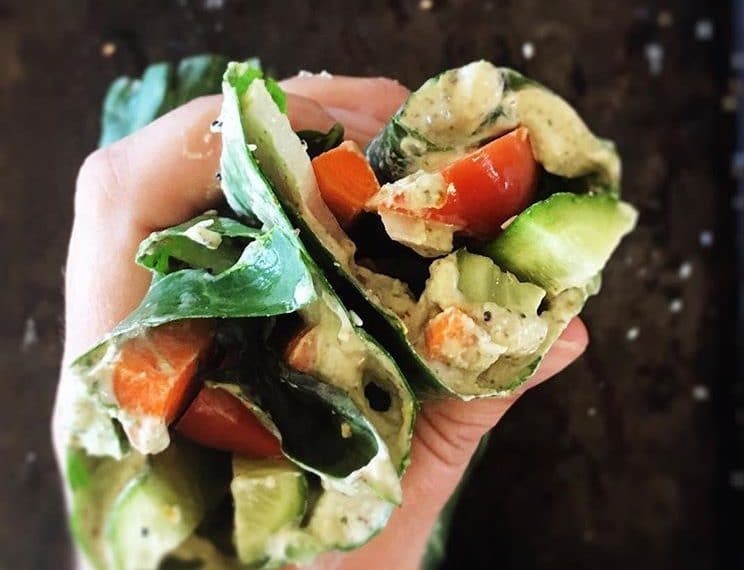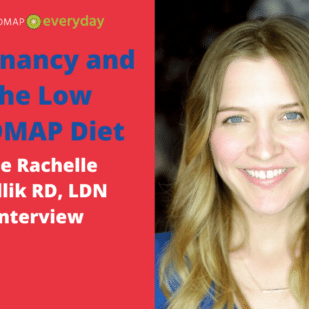The EA Stewart Interview
EA Stewart, also known as The Spicy RD, is a nutrition coach and digestive health expert based in the Del Mar/San Diego, CA area, who also consults around the world. We first became aware of EA when she responded to our call for our RDN Resource List and we also kept seeing her friendly, positive comments on social media.
She has been featured in BuzzFeed, The Huffington Post, Men’s Health, Fitness, Shape and a slew of other media. Her website features her fabulous photography and you can see right away that she is a real food person.
I saw a quote of hers that said, “If You Are What You Eat, Why Not Be Delicious” and that sealed the deal; I knew we had to connect.
Dédé Wilson: EA (pronounced like the letters in succession, “E”, “A”) thank you so much for chatting. We finally got to meet at FNCE 2017 (the Food & Nutrition Conference and Expo put on by the Academy of Nutrition and Dietetics), which was great. Being newer to this FODMAP scene, Robin and I knew it was important to get there and meet dietitians like you in person.
Let’s introduce you to our community – tell us about your practice and overall approach to nutrition counseling.
EA: Thanks so much for having me here & introducing me to your readers! I LOVE my job! In my private practice I work mostly with clients, virtually and in-person, with digestive health issues {IBS, IBD, SIBO, celiac disease, gluten sensitivity} and autoimmune disease. Many of my clients have seen multiple doctors and other healthcare providers before they come to see me.
It’s incredibly rewarding helping them peel back the multiple layers contributing to their illness, and showing them how nourishing (and delicious!) food, along with a healthy lifestyle, can help them thrive and feel good again. Although I don’t have IBS, I do know what it’s like to deal with a chronic health condition and follow a restricted diet, so I have a lot of empathy working with my clients, and am dedicated to helping them find dietary and lifestyle solutions that work specifically for them.
The other side of my business involves nutrition communications. I have a blog, The Spicy RD, where I share easy, nourishing, gluten-free recipes {plus a growing number of low FODMAP recipes too!}, integrative nutrition advice, and healthy living tips. In addition, I do food photography, recipe development, freelance writing, professional speaking, and social media. I really love what I do!

How did you first learn about the low FODMAP diet? For about what percentage of your clients do you end up recommending the diet?
When I started my private practice, about 7 years ago, I worked for the National Foundation for Celiac Awareness (now called Beyond Celiac), as one of their “Ask the Dietitian” experts. This helped attract people with celiac disease and gluten sensitivity to my website, as well as clients with IBS, since, as you know, there tends to be an overlap with these conditions.
Although I knew little about IBS at the time, my parents instilled a love of learning in me, so I researched everything I could about diet and IBS. Luckily this lead me to Monash University and the work of dietitian IBS experts Kate Scarlata and Patsy Catsos.
I took one of their Low FODMAP diet workshops early on, and have been utilizing the diet with almost all of my IBS clients ever since.
You have been very public about sharing your own personal health issues and your diagnosis of Sjogren’s Syndrome. Please tell us more about what it is, how it intersects with gluten sensitivities and whether there is any overlap with the low FODMAP diet.
I’m so glad you asked! Sjogren’s Syndrome is one of the most common autoimmune diseases, yet very few people have heard of it. I wrote this post on diet, autoimmune disease and Sjogren’s Syndrome last year, as a way to raise awareness.
In a nutshell, Sjogren’s symptoms, including joint pain, neuropathy, and fatigue, overlap other autoimmune diseases such as rheumatoid arthritis, lupus, and multiple sclerosis. The hallmark symptoms of Sjogren’s Syndrome are extreme dry eyes and dry mouth.
In addition, Sjogren’s may potentially lead to organ dysfunction, plus those affected have a higher than average risk of developing lymphoma.
As with many autoimmune diseases, there’s no “one fits all” constellation of symptoms. I actually did not have dye eyes or dry mouth, but instead I experienced neuropathy (my big toe went numb which is what triggered my first visit to a doctor}, severe muscle aches, insomnia, body rashes, and exercise intolerance, along with joint pain and extreme fatigue.

Like many of my patients with autoimmune disease, it took me several years (and doctors) to get a diagnosis. Sadly, once I did, the only option I was given, was to take medication with potentially severe side effects, so I started researching everything I could about Sjogren’s, autoimmune disease, and diet.
Although I did not personally have any digestive symptoms, patients with Sjogren’s have been found to have more frequent gastrointestinal disease, including IBS. During my research, I also uncovered a link with celiac disease (studies show that celiac disease is far more common in Sjögren’s – up to 15% more than in the general population -~1%.}, and asked my physician to test me for celiac disease.
My results came back negative, but I decided to try a gluten-free diet anyways, and, gradually, over the next 6 months, all my symptoms disappeared. I have been following a gluten-free diet ever since!
You also talk and educate about MRT food sensitivity testing and the LEAP elimination diet. Can you elaborate for us?
Sure, absolutely! MRT stands for Mediator Release Testing. It’s a blood test that measures the release of “mediators” (i.e. cytokines, histamine, prostaglandins, etc.} from white blood cells, in response to 170 different foods and food chemicals.
These mediators may lead to inflammation in the body, as well as digestive symptoms, headaches, extreme fatigue, and more.
LEAP {Lifestyle, Eating, and Performance} is a patient specific elimination diet based on an individual’s MRT test results. The beauty of this diet is that it is highly individualized, meaning patients can expect to see resolution of their symptoms very quickly.
Do you think that if someone is following the low FODMAP diet precisely and is still having digestive issues – and/or other issues like headache, GERD or Fibromyalgia – that MRT or LEAP might help? What would be the process for determining this and what are the initial steps for addressing concurrent issues?
Yes! Although I typically start my IBS patients on a low FODMAP diet, I have had lots of success with MRT testing and a LEAP elimination diet for many of my patients who fail to have a significant reduction in symptoms on a Low FODMAP diet.
Research shows that IBS-D patients tend to respond better to a LEAP diet than those with IBS-C. Also, as you mention above, if someone has additional diagnoses outside of IBS {i.e. fibromyalgia, migraine, autoimmune disease}, I might recommend they start with MRT testing and a LEAP elimination diet. Then, later I will also assess if FODMAPs need to be addressed too.
I really want to provide my clients with the least restrictive diet that will get them feeling good again, so I offer a free screening tool to help decide what is the best diet {i.e. Low FODMAP vs MRT/LEAP} to start with. If any of your readers are interested, they can get in touch with me.

Wow, I am really play-acting as an amateur dietitian today with the big words and hard questions but I know that our community is interested. Another term we see a lot these days is Leaky Gut Syndrome. Can you take us through what that is – and again, whether there is an intersection with the low FODMAP diet?
Ha, ha-yes, big words! Leaky Gut Syndrome {LGS} is more commonly referred to as “increased intestinal permeability” by the medical community. It occurs when a complex of proteins, aka “tight junctions”, which line the intestinal cells, stop working properly.
This in turn can allow proteins and microorganisms to “leak” into the bloodstream, potentially causing the immune system to react and lead to symptoms including fatigue, gas, bloating, and diarrhea.
To date, the research on FODMAPs and intestinal permeability is limited, although I am aware of one recent study that found improved nociceptive pain on a low FODMAP diet via a change in gut microbiota and intestinal permeability. I’m definitely looking forward to more research in this area!
OK let’s talk fun stuff. Your food photography is just fantastic. Were you always a photographer and great home cook? How do you develop recipes; what inspires you?
Thank you so much! My love of photography started when I was a teenager. My dad was an amateur photographer and we had a darkroom at our house. This was way back when we still had to put film in our cameras – ha!
I became interested in black and white photography, and, in addition to taking and developing pictures for fun, I also worked for the school newspaper in college
As far as cooking goes, my parents like to tell the story that they found me teetering on a chair, at the age of two, cooking scrambled eggs on the stove {so much for parental supervision!}

Great cooks think alike! My first cooking forays were with omelets at about age 5!
To tell the truth though, I always loved to bake with my mom, but I never considered myself a “cook “until I started my gluten-free diet. Before that, I always followed recipes, but going gluten-free forced me to get creative in the kitchen.
These days, I enjoy creating simple recipes around seasonal produce, fresh herbs, and spices. I use the Mediterranean Diet as my inspiration, and consult the Vegetarian Flavor Bible for creative and delicious flavor combinations. I am so fortunate to live in Southern California where I have access to fresh, seasonal produce year round!
Tell us about cooking classes that you teach. We certainly agree with you about giving people practical, everyday tools and showing them how to cook is a powerful and very useful skill.
Teaching cooking classes is something I just started doing last year. My impetus was one of my clients who I had been working with for a couple of years. He has pretty severe IBS, and had tested positive for SIBO but failed to respond to antibiotic treatment.
After consulting with some of the best IBS specialists, the only thing he found even a little helpful, was a low FODMAP diet. The only problem? He hates to cook! So, I brainstormed ideas to help him, and eventually suggested low FODMAP cooking classes at his house.
Since then, I have been going to his house every month to cook with him. I think the main benefit for him, has been getting him to try new low FODMAP recipes – something he wouldn’t do on his own – and realizing that delicious meals don’t have to be complicated.
One more FODMAP question. What do you see as the future of this diet? Do you think Americans will embrace it the way we hope?
I think we’re at the tip of the iceberg as far as the low FODMAP diet goes. I was recently on a girl’s trip in Healdsburg with friends from High School, and, as it often does, the topic turned to food and diets. And, also, digestive issues! Naturally I brought up the low FODMAP diet, and it became the topic of the weekend.
What I have found, is that most of my clients with IBS have heard of the low FODMAP diet, and fortunately many GI docs are recommending it to their patients, but most of the general public has not.
When I talk to my friends, however, I find that digestive complaints are VERY common, so that’s when I suggest a trial of the low FODMAP diet. And, the best thing is, that, in the majority of people who try it, it works!
At the same time, I think it’s SO important to treat everyone individually, as the low FODMAP diet doesn’t help 100% of the time. I love working in the field of nutrition, but one of the things that drives me crazy, is when health “experts” suggest certain foods should be avoided by everyone – not true!
Just because I feel great on a gluten-free diet, doesn’t mean I think all of my clients need to eliminate gluten from their diets. Phew! Thanks for letting me share!
EA thank you so much for your time. We are looking forward to what we can cook up together in the future. We share a very integrative approach to FODMAP education and are grateful for the work you do with those in need.








